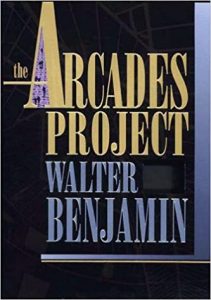 Jenny’s post is right: the obvious, and boring, choice would be a survival guide of some sort. As an eighteenth-century specialist, I’d even be tempted to get too cute and say Robinson Crusoe: Daniel Defoe’s 1719 classic about a shipwrecked sailor learning to survive, often considered one of the most important and influential early novels. In the spirit of the exercise, however, I’ll pick something that rewards re-reading––something I’d want to sit with and ponder, something I could keep reading and thinking about for years until my eventual rescue. My choice is…
Jenny’s post is right: the obvious, and boring, choice would be a survival guide of some sort. As an eighteenth-century specialist, I’d even be tempted to get too cute and say Robinson Crusoe: Daniel Defoe’s 1719 classic about a shipwrecked sailor learning to survive, often considered one of the most important and influential early novels. In the spirit of the exercise, however, I’ll pick something that rewards re-reading––something I’d want to sit with and ponder, something I could keep reading and thinking about for years until my eventual rescue. My choice is…
The Arcades Project by Walter Benjamin
There are definitely fiction writers whose voices I’ve loved, but as often as not the writers who inspire me most are nonfiction or criticism writers––they’re the ones who made me want to become a literary critic. One of the writers who still holds magic for me is Walter Benjamin (and I’m not alone in this, naming him as a critic who inspires you is almost cliché in my field). Benjamin wrote on pretty much everything––translation, Kafka, the philosophy of history, seventeenth-century drama, hashish, photography––and all his writings are laden with beautiful, compact, breathtaking sentences. Benjamin wrote of Kafka that his stories “unfold as a bud unfolds into a blossom”; the same could be said of Benjamin’s own writings, which pack an extraordinary complexity into the elegant little sentences and phrases.
 Benjamin died fleeing the Nazis, survived by fellow German intellectuals like Hannah Arendt, Theodor Adorno, Bertholt Brecht, and Arthur Koestler (technically Hungarian, Judit reminds me) who managed to escape. When he died he left behind a sprawling set of notes for a project called Das Passagenwerk, or The Arcades Project: loosely, an attempt to understand the nineteenth century inspired by Paris’ enclosed shopping alleys or “arcades.” Every now and then I’ll flip through my copy, wandering around through his brilliant observations like a shopper at the Arcades. I’m not sure he’d have approved of the simile, but it’s hard not to be dazzled by these gorgeous fragments of his thought.
Benjamin died fleeing the Nazis, survived by fellow German intellectuals like Hannah Arendt, Theodor Adorno, Bertholt Brecht, and Arthur Koestler (technically Hungarian, Judit reminds me) who managed to escape. When he died he left behind a sprawling set of notes for a project called Das Passagenwerk, or The Arcades Project: loosely, an attempt to understand the nineteenth century inspired by Paris’ enclosed shopping alleys or “arcades.” Every now and then I’ll flip through my copy, wandering around through his brilliant observations like a shopper at the Arcades. I’m not sure he’d have approved of the simile, but it’s hard not to be dazzled by these gorgeous fragments of his thought.
These notes are at one level a kind of theoretical jigsaw puzzle: how did Benjamin intend to fit poet Charles Baudelaire, mathematician Joseph Fourier, the stock exchange, idleness and boredom, railroads, Karl Marx, mirrors, jugendstil décor, fashion, and the practice of collecting all into one “Grand Theory of the Nineteenth Century”? You could spend a lifetime trying to retrace his steps and never be sure. I’d want an enormous corkboard, string, and post-it notes on my desert island to try and fit it all together. If the big picture is at once exciting and elusive, so are the individual fragments. Consider this one:
“Trace and aura. The trace is appearance of a nearness, however far removed the thing that left it behind may be. The aura is appearance of a distance, however close the thing that calls it forth. In the trace, we gain possession of the thing; in the aura, it takes possession of us” (The Arcades Project, ed. Rolf Tiedemann, trans. Howard Eiland and Kevin McLaughlin [Cambridge, MA: Harvard University Press, 1999], 447).
If you ever figure out what that means, please let me know. I’ll be waiting on my desert island.
More in the series
- The Best of Roald Dahl by Roald Dahl (stories for adults by author popular with children) – read the post by Julie Rossano
- The Fifth Season by N K Jemisin and The House in the Cerulean Sea by TJ Klune (one for the brain, one for the heart) – read the post by Jenny Coffman
- The Good Soldier Švejk by Jaroslav Hašek (1921-1923, satirical dark comedy) – read the post by Judit Ward